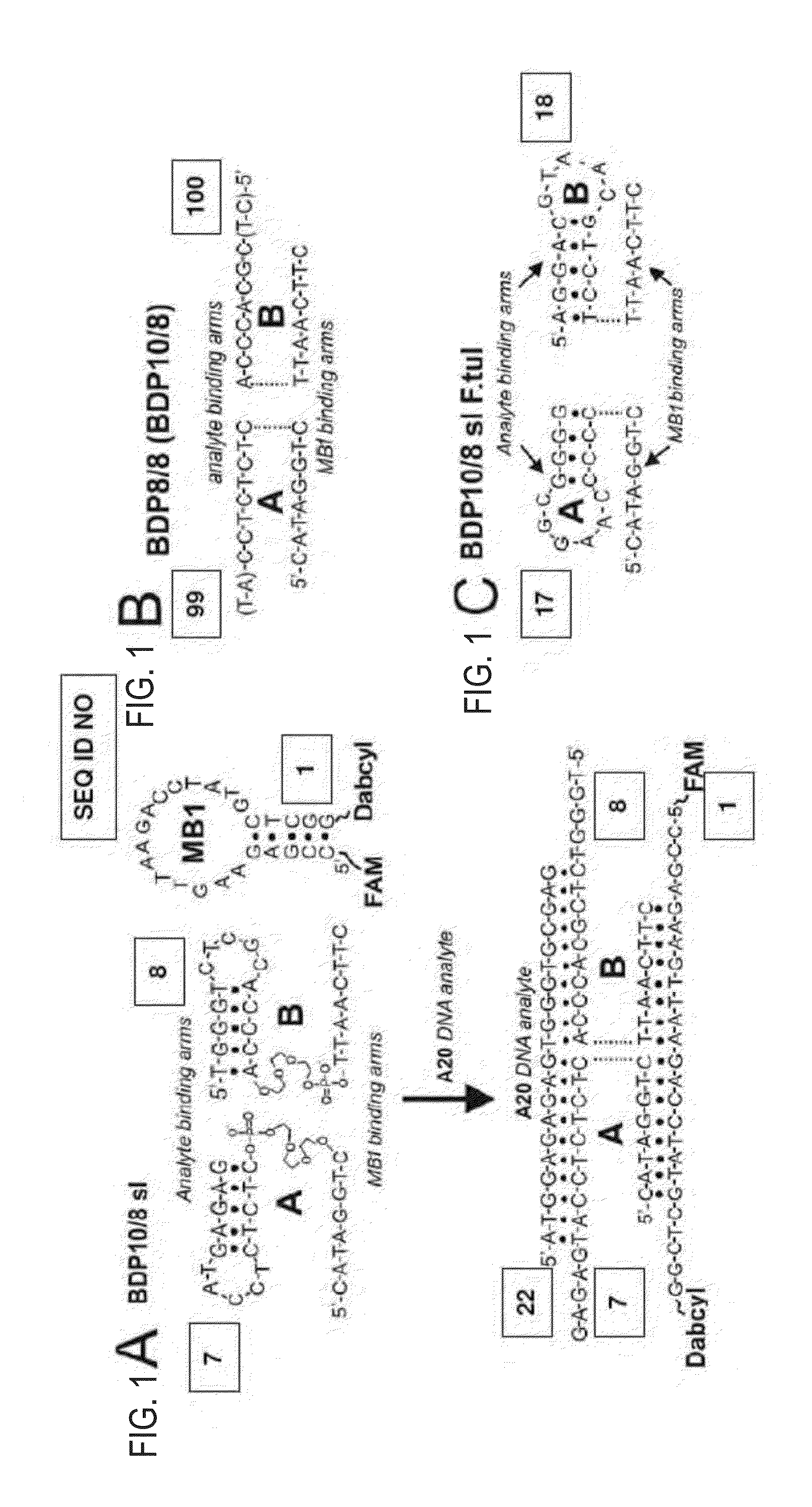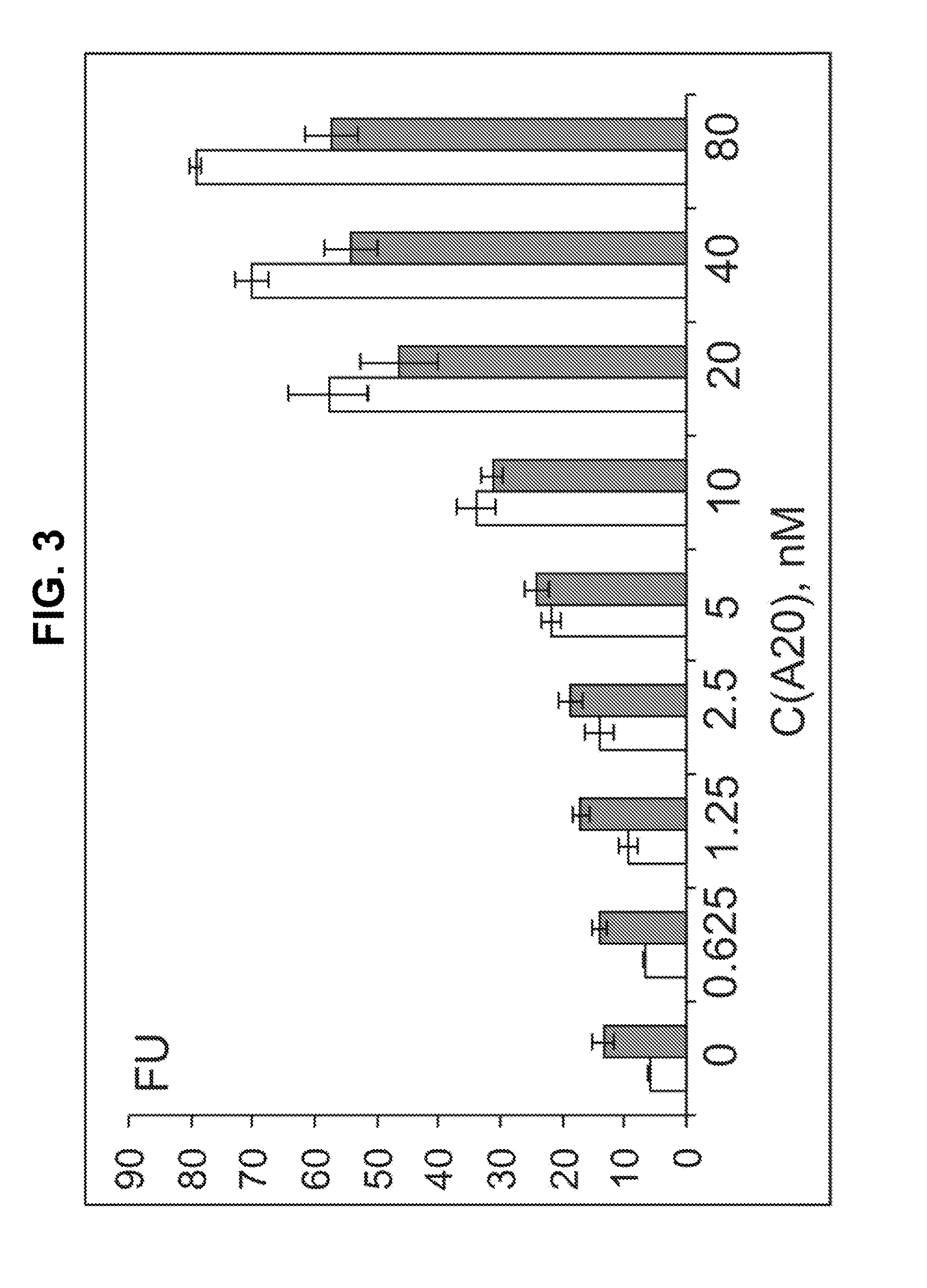Binary DNA Probe for Fluorescent Analysis of Nucleic Acids
a nucleic acid and fluorescent analysis technology, applied in the field ofbinary probes for fluorescent analysis of nucleic acids, can solve the problems of inability to select and use known methods, and inability to detect nucleotide hybrid duplexes in living cells, etc., to achieve more stable results
- Summary
- Abstract
- Description
- Claims
- Application Information
AI Technical Summary
Benefits of technology
Problems solved by technology
Method used
Image
Examples
example 1
Binary DNA Probes
A. Materials:
[0122]DNAse / RNAse free water was purchased from ICN (Costa Mesa, Calif.) and used for all buffers, and for stock solutions of oligonucleotides. Oligonucleotides were custom-made by Integrated DNA Technologies, Inc. (Coralville, Iowa) and were used as received. Fluorescent spectra were taken on a Perkin-Elmer (San Jose, Calif.) LS-55 Luminescence Spectrometer with a Hamamatsu Xenon lamp. Experiments were performed at the excitation wavelength of 485 nm and emission scan of 500-550 nm. The emitting intensities at 517 nM were taken for the calculation of the discrimination factors. The data of four independent experiments were processed using Microsoft Excel.
B. Discrimination Factors (DFs) for BDPs
[0123]The solutions of MB1 (20 nM), strands A and B (500 nM for BDP10 / 8sl and BDP10 / 8sl F .tul or 200 nM for BDP8 / 8 and BDP10 / 8) in 120 μl of 50 mM MgCl2, 10 mM Tris HCl, pH 7.4 were incubated in the presence of either 40 nM A20 or one of the single base-substitu...
example 2
Binary Malachite Green Binding Probe
[0126]A. Materials.
[0127]DNAse / RNAse free water was purchased from ICN (Costa Mesa, Calif.) and used for all buffers, and for stock solutions of olionucleotides. Malachite Green was purchased from Sigma-Aldrich Co (Milwaukee, Wis.). Oligonucleotides were custom-made by Integrated DNA Technologies, Inc. (Coralville, Iowa) and were used as received. The structures of the oligoribonucleotides were as follows: 5′-GCACCCA UU UCCC GA C UGG (SEQ ID NO: 95) and 5′-CCAG G UAA CGA AU GGA UU CUC UCU C (SEQ ID NO: 96). The structure of A14 DNA analyte was gagagag tgggtgc (SEQ ID NO: 52) while the structures of single base substituted oligodeoxyribonucleotides are presented in the Table 2.
[0128]B. Binary Malachite Green Aptamer Probe.
[0129]MG (2 μM) and two RNA strands of biMGA probe (1 μM each) were mixed in 5.3 ml of the buffer containing 50 mM TrisHCl pH 7.4, 140 mM NaCl, 5 mM KCl, 1 mM MgCl2. The solution was distributed into 44 tubes (120 μl in each tube)...
example 3
Fluorescent Oligonucleotide Tandems
Analysis of the Gaps of Different Length.
[0132]First we examined the fluorescence response of tetra-, penta- and hexanucleotide gaps to the presence of gap-filling oligonucleotides (FIG. 2). It was found that all FOTs tested increased fluorescence upon addition of cognate oligonucleotides, i.e. oligonucleotides fully complementary to the analyte gap sequence where the SNP site is. Fully complementary binding of the gap-filling oligonucleotide to the analyte gap region causes the formation (or completion) of a double helix that in turn increases fluorescence by moving or shifting the fluorophore away from the quencher. (FIG. 2, right panels). The signal-to-background (S / B) ratios were 1.2, 2.0 and 2.5 for tetra-, penta- and hexanucleotide gaps, respectively. We concluded that penta- and hexanucleotide gaps were the most suitable for FOT approach. For further experiments we chose five-nucleotide gaps since sensitivity of pentanucleotide to single bas...
PUM
 Login to View More
Login to View More Abstract
Description
Claims
Application Information
 Login to View More
Login to View More - R&D
- Intellectual Property
- Life Sciences
- Materials
- Tech Scout
- Unparalleled Data Quality
- Higher Quality Content
- 60% Fewer Hallucinations
Browse by: Latest US Patents, China's latest patents, Technical Efficacy Thesaurus, Application Domain, Technology Topic, Popular Technical Reports.
© 2025 PatSnap. All rights reserved.Legal|Privacy policy|Modern Slavery Act Transparency Statement|Sitemap|About US| Contact US: help@patsnap.com



